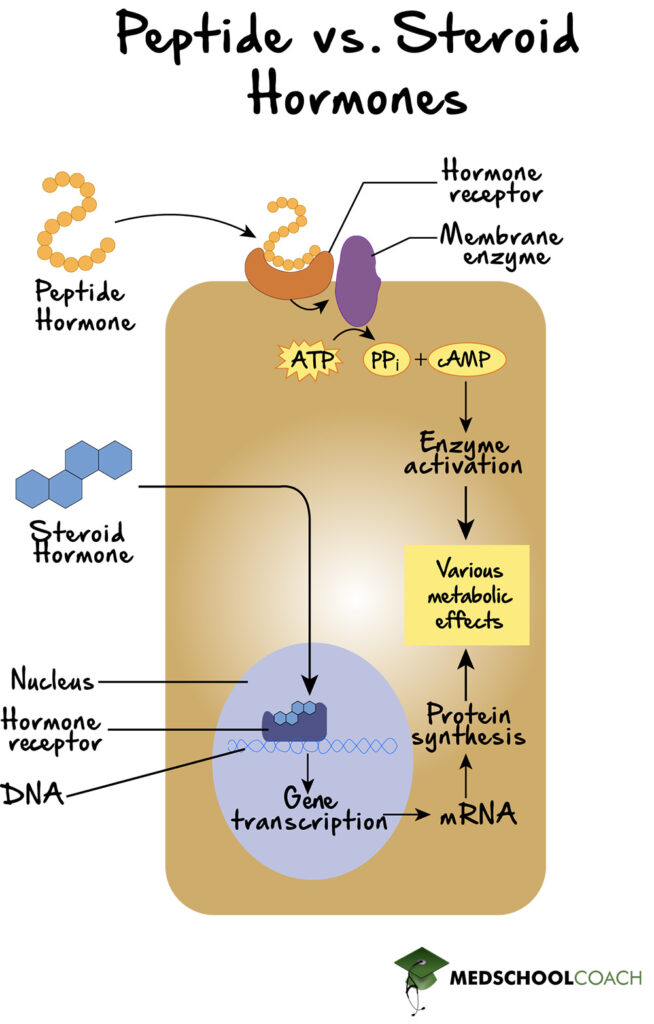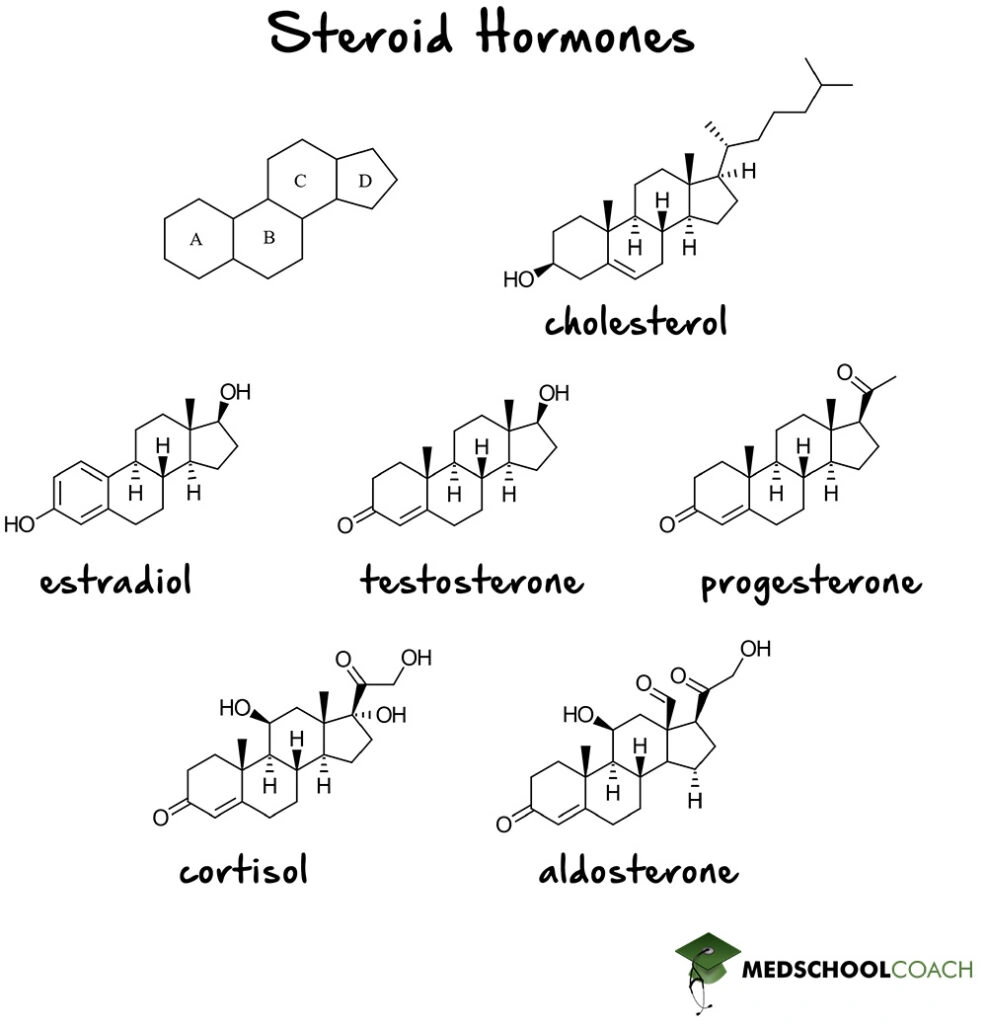Types of Hormones
MCAT Biology - Chapter 7 - Section 2.3 - Organ Systems - Endocrine System
- Home
- »
- MCAT Masterclass
- »
- Biological and Biochemical Foundations of Living Systems
- »
- Biology
- »
- Types of Hormones – MCAT Biology
Sample MCAT Question - Types of Hormones
Which of the following is true regarding peptide hormones?
a) They are slow-acting but have long-lasting effects.
b) They are fast-acting and have long-lasting effects.
c) They bind to intracellular receptors.
d) They are fasting-acting but have short-lived effects.
D is correct. Peptide hormones are fasting-acting but have short-lived effects.
Peptide hormones exert their effects through cell surface receptors (choice C is incorrect). When a peptide hormone binds to a membrane receptor, it activates a signal transduction pathway, which leads to the phosphorylation or dephosphorylation of different proteins within the cell. These proteins, known as secondary messengers, mediate the intracellular effects of peptide hormones. These effects tend to occur quickly because secondary messengers are already present within the cell (choice A is incorrect). However, since the action of peptide hormones doesn’t necessarily lead to long-term changes in gene transcription, its effect is generally short-lived (choice B is incorrect). Since steroid hormones diffuse through the cell membrane and bind to transcription factors, they tend to cause changes in the transcription of genes themselves. These changes are slower because transcription takes time. However, they also tend to have longer-lasting effects, since transcriptional changes are more fundamental than the temporary activation of proteins.
Get 1-on-1 MCAT Tutoring From a Specialist
With MCAT tutoring from MedSchoolCoach, we are committed to help you prepare, excel, and optimize your ideal score on the MCAT exam.
For each student we work with, we learn about their learning style, content knowledge, and goals. We match them with the most suitable tutor and conduct online sessions that make them feel as if they are in the classroom. Each session is recorded, plus with access to whiteboard notes. We focus on high-yield topics if you’re pressed for time. If you have more time or high-score goals, we meticulously cover the entire MCAT syllabus.
What Are Hormones?
Hormones are signaling molecules released in the blood that regulate physiology and behavior. As stated in an earlier post, hormones are released by endocrine glands. There are three types of hormones – peptide hormones, steroid hormones, and tyrosine derivatives. It is essential to understand the difference between all three types of hormones for the MCAT exam.
Peptide Hormones vs Steroid Hormones
Most hormones are either peptide hormones and steroid hormones. Figure 3 illustrates how peptide hormones and steroid hormones differ. The main difference between these two types of hormones is the type of receptors they bind to and how they elicit responses in the cell.
Peptide hormones are polar molecules, and because of this, they cannot pass through the phospholipid bilayer on cells. Instead, they bind to cell surface receptors, which activate a signal transduction pathway, leading to the phosphorylation or dephosphorylation of different proteins within the cells. These intracellular proteins are known as secondary messengers, and once they are activated, they may phosphorylate or dephosphorylate other intracellular proteins or enzymes. Thus, the signal delivered by peptide hormones is amplified throughout the cell, resulting in a larger response. This response also tends to be fast because the secondary messengers are already present within the cell — the signal just needs to be turned on or off. However, since the action of peptide hormones doesn’t necessarily lead to long-term changes in gene transcription, its effect is generally short-lived. Some examples of peptide hormones include glucagon, insulin, prolactin, oxytocin, and cholecystokinin (CCK).
Steroid hormones, on the other hand, are nonpolar molecules and can pass directly through the cell membrane. In this way, they bind to intracellular receptors that will ultimately enter the nucleus and modify transcription. Like peptide hormones, steroid hormones will also lead to a change in cells to produce a response. However, these changes tend to be slower and longer-lasting than the changes triggered by peptide hormones. This is because steroid hormones act on the level of transcription, which results in the production of new mRNA molecules, which then have to be translated into proteins. This process takes time. It also has longer-lasting effects, since transcriptional changes are more fundamental than the temporary activation of proteins. In some cases, the effects of steroid hormones are permanent such as the effects of the reproductive hormones on sexual development.

Chemical Structure of Peptide and Steroid Hormones
Another difference between peptide and steroid hormones lies in their chemical composition.
Peptide hormones, as their name implies, are made of amino acids. These amino acid sequences can be of varying sizes. Some sequences can consist of a few amino acids, while others may consist of many amino acids. In this way, peptide hormones can be different sizes relative to each other.
Steroid hormones, on the other hand, are derived from cholesterol. Figure 4 shows the chemical structure of cholesterol, as well as a few examples of steroid hormones. The most prominent feature of the cholesterol molecule is the ring structure. Cholesterol molecules contain either six-membered rings or five-membered rings, and recognizing this structure is important for the MCAT exam.

Tyrosine Derivatives
The last type of hormone is tyrosine derivatives. Tyrosine derivatives are derived from the amino acid tyrosine. There are two different types of tyrosine derived hormones – the thyroid hormones and the catecholamines.
Thyroid hormones are like steroid hormones in that they can pass directly through the cell membrane and bind to intracellular receptors. Catecholamines, on the other hand, which include epinephrine and norepinephrine, act like peptide hormones. They bind to cell surface receptors, and their effects, like peptide hormones, are very fast. For example, the catecholamines control the fight or flight response, which may take seconds to trigger and which may last only about 10 minutes in total. It is important to note that although tyrosine derivatives may behave like peptide or steroid hormones, they still have different structures.
Explore More MCAT Masterclass Chapters
Take a closer look at our entire MCAT Masterclass or explore our Biochemistry lessons below.

One-on-One Tutoring
Are you ready to take your MCAT performance to a whole new level? Work with our 99th-percentile MCAT tutors to boost your score by 12 points or more!
See if MCAT Tutoring can help me
Talk to our enrollment team about MCAT Tutoring

MCAT Go Audio Course
Engaging audio learning to take your MCAT learning on the go, any time, any where. You'll be on the way to a higher MCAT score no matter where you are. Listen to over 200+ lessons.

MCAT Practice Exams
Practice makes perfect! Our mock exams coupled with thorough explanations and in-depth analytics help students understand exactly where they stand.

MCAT Prep App
Access hundreds of MCAT videos to help you study and raise your exam score. Augment your learning with expert-created flashcards and a question banks.